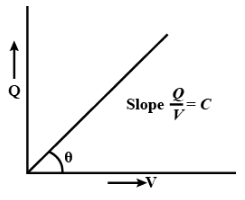
Sketch graph to show how $Q$ given to a capacitor $C$ charge varies with the potential difference.
Answer
502.2k+ views
Hint: The ratio of the amount of electric charge deposited on a conductor to the difference in electric potential is known as capacitance. Self-capacitance and reciprocal capacitance are two closely related concepts of capacitance. Self-capacitance is a property of any material that can be electrically charged.
Complete answer:
The electric potential difference between the target and the ground is determined in this situation. At a given potential difference, a substance with a high self capacitance carries more electric charge than one with a low capacitance. Knowledge of the action of the capacitor, one of the three basic linear electronic elements, requires an understanding of mutual capacitance (along with resistors and inductors).
The following is the relationship between the potential through the plates and the charge on the capacitor. As a result, we can see that V is proportional to $Q$. As a result, the graph must be a straight line from the origin with a positive slope.
$Q = C V$
It is of the form
$y=mx$
Here, $m=C$
$Q \propto V$

The graph between $V$ and $Q$ is initially a straight line. However, after a certain point, charge leakage begins, and $V$ does not rise as $Q$ increases. The below figure depicts this difference.

Note: Two conductors, one positively charged and the other negatively charged, are used to divide electric charge in a typical capacitor, but the circuit has a cumulative charge of zero. The amplitude of the electric charge on each conductor is the ratio in this case, and the potential differential is the difference determined between the two conductors.
Complete answer:
The electric potential difference between the target and the ground is determined in this situation. At a given potential difference, a substance with a high self capacitance carries more electric charge than one with a low capacitance. Knowledge of the action of the capacitor, one of the three basic linear electronic elements, requires an understanding of mutual capacitance (along with resistors and inductors).
The following is the relationship between the potential through the plates and the charge on the capacitor. As a result, we can see that V is proportional to $Q$. As a result, the graph must be a straight line from the origin with a positive slope.
$Q = C V$
It is of the form
$y=mx$
Here, $m=C$
$Q \propto V$

The graph between $V$ and $Q$ is initially a straight line. However, after a certain point, charge leakage begins, and $V$ does not rise as $Q$ increases. The below figure depicts this difference.

Note: Two conductors, one positively charged and the other negatively charged, are used to divide electric charge in a typical capacitor, but the circuit has a cumulative charge of zero. The amplitude of the electric charge on each conductor is the ratio in this case, and the potential differential is the difference determined between the two conductors.
Recently Updated Pages
Master Class 12 Economics: Engaging Questions & Answers for Success

Master Class 12 Maths: Engaging Questions & Answers for Success

Master Class 12 Biology: Engaging Questions & Answers for Success

Master Class 12 Physics: Engaging Questions & Answers for Success

Basicity of sulphurous acid and sulphuric acid are

Master Class 12 Business Studies: Engaging Questions & Answers for Success

Trending doubts
What are the major means of transport Explain each class 12 social science CBSE

Which are the Top 10 Largest Countries of the World?

Draw a labelled sketch of the human eye class 12 physics CBSE

How much time does it take to bleed after eating p class 12 biology CBSE

Explain sex determination in humans with line diag class 12 biology CBSE

Differentiate between homogeneous and heterogeneous class 12 chemistry CBSE




